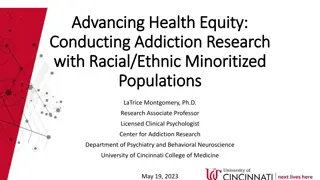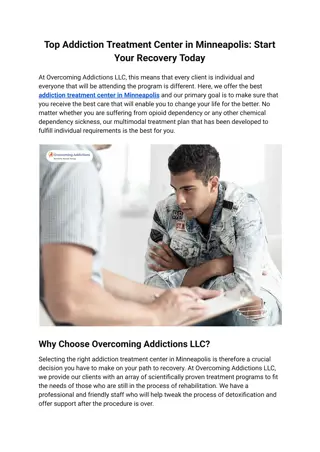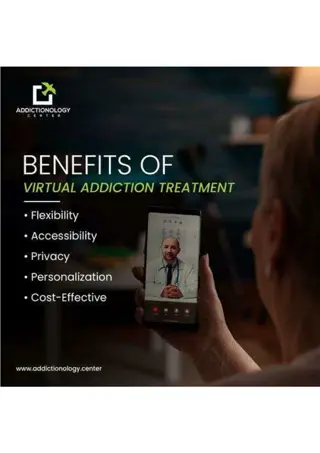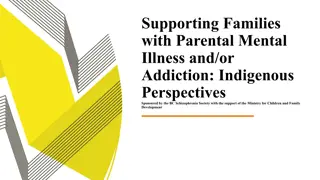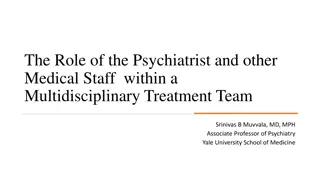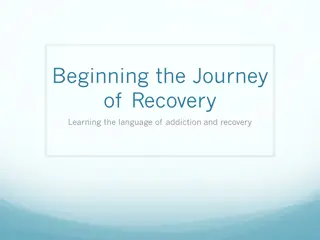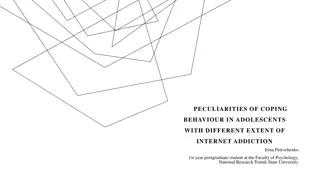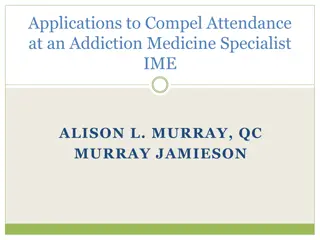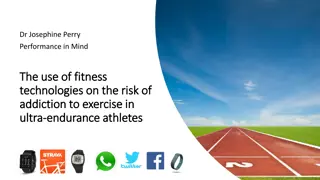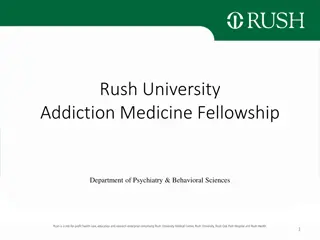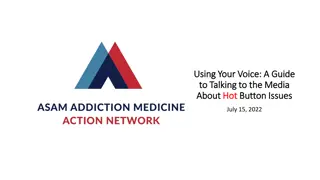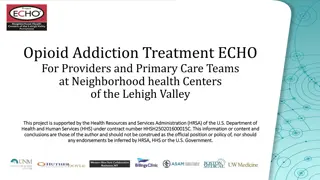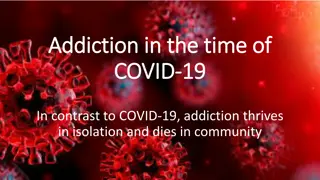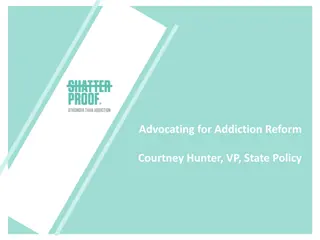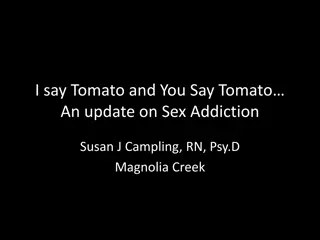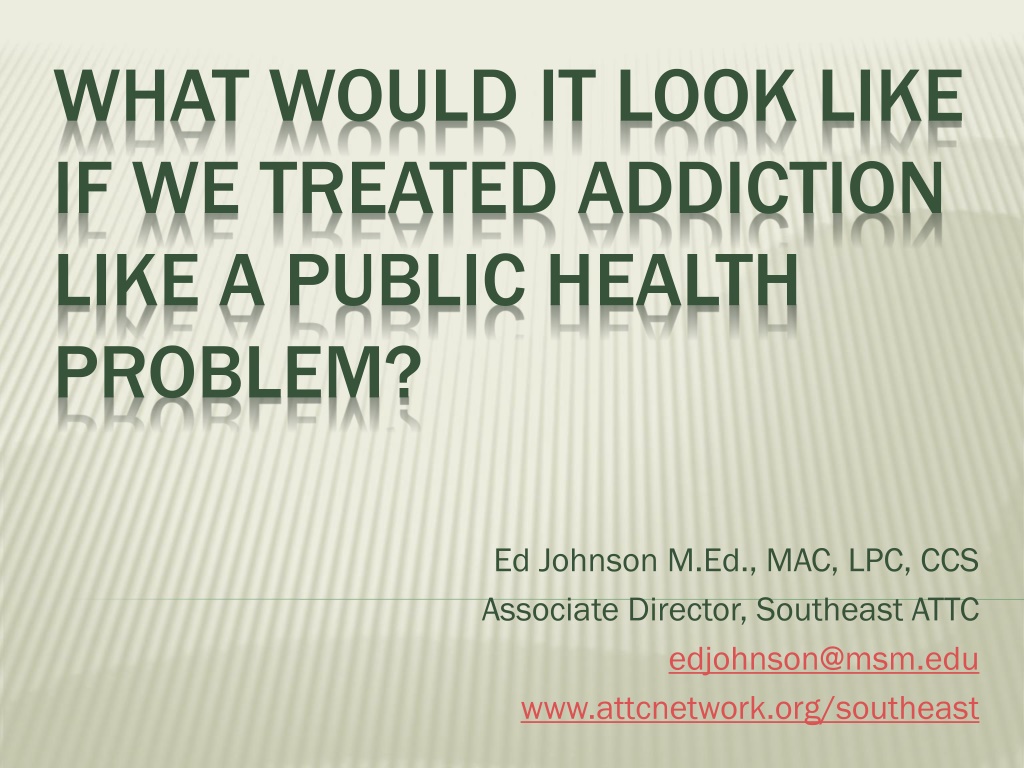
Redefining Addiction as a Public Health Issue
Explore the shift in perspective to treat addiction as a public health problem, addressing stigma, learning objectives, behavioral traits associated with addiction, causes, and the debate between choice and disease models. Considerations for treating addiction within a public health framework are discussed.
Download Presentation

Please find below an Image/Link to download the presentation.
The content on the website is provided AS IS for your information and personal use only. It may not be sold, licensed, or shared on other websites without obtaining consent from the author. If you encounter any issues during the download, it is possible that the publisher has removed the file from their server.
You are allowed to download the files provided on this website for personal or commercial use, subject to the condition that they are used lawfully. All files are the property of their respective owners.
The content on the website is provided AS IS for your information and personal use only. It may not be sold, licensed, or shared on other websites without obtaining consent from the author.
E N D
Presentation Transcript
WHAT WOULD IT LOOK LIKE IF WE TREATED ADDICTION LIKE A PUBLIC HEALTH PROBLEM? Ed Johnson M.Ed., MAC, LPC, CCS Associate Director, Southeast ATTC edjohnson@msm.edu www.attcnetwork.org/southeast
LEARNING OBJECTIVES What criteria must be met for a medical condition to be a Disease Explore the Acute Care and Chronic Care models and how they relate to AOD Treatment What is the Public Health Model and how it relates to AOD Prevention. Discuss how our language reflects our concepts of AOD Treatment and Prevention.
STIGMA Stigma A mark of disgrace or infamy associated with a particular circumstance, quality or person.
WHAT IS ADDICTION? Is it willful misconduct or Is it a Medical Condition?
CHOICE VS. DISEASE CHOICE DISEASE Free Will Exists Responsibility Can Stop Punishment and Coercion do work Behaviors can be controlled No Free Will No Responsibility Can t Stop Punishment and Coercion don t work They have Symptoms
THE CHOICE ARGUMENT Addiction can t be a Disease because it s a Behavior An Addict can quit anytime, they just need the right motivation
SO WHAT ARE SOME OF THE BEHAVIORS THAT COME TO MIND WHEN YOU THINK OF PEOPLE WITH ADDICTION?
BEHAVIORS OF FOLKS WITH ADDICTION Lying Cheating Stealing Manipulating Irresponsibility Denial Selfishness Lack of Caring
CAUSES OF THOSE BEHAVIORS Sociopath Criminality Self-Centered Character Defects Addicted Personality Demonic Possession Gang Culture Bad Parenting
DISEASE THEORY Organ Defect Symptoms
Organ Defect Symptoms Blurred Vision, Numbness, Coma Islet Cells Death Pancreas Screaming, Bleeding, Deformity Femur Fracture See ? Badness Behaviors
BEHAVIORS OF FOLKS WITH ADDICTION Lying Cheating Stealing Manipulating Irresponsibility Denial Selfishness Lack of Caring
THE MIDBRAIN The Survival part of the Brain Focuses on Three things: Eat Kill (Defend) Sex (Procreate) Processing Center for all incoming information
VULNERABILITIES FOR ADDICTION Genetic Developmental/Emoti onal Psychiatric Co- Morbidity Chronic Pain Stress Early Physical or Sexual Abuse Drug Used Route of Administration Dose Frequency Length of Use Availability Acceptability (peers who use) Witnessing Violence
WHAT PUSHES SOMEONE OVER THE LINE IS STRESS STRESS
STRESS = SEVERE Face the same Severity of Stress Face the same Pattern of Stress Have the same functioning Coping Mechanisms Come to the table with the Same Brain
CHRONIC STRESS Chronic levels of Stress Hormones cause a defect in the Limbic System of the Brain (over production of dopamine). This defect affects the brains ability to properly perceive Pleasure
WHAT IS ADDICTION? Addiction is a primary chronic disease of brain reward, motivation, Addiction is a primary chronic disease of brain reward, motivation, memory and related circuitry. Dysfunction in these circuits leads to memory and related circuitry. Dysfunction in these circuits leads to characteristic biological, psychological, social and spiritual characteristic biological, psychological, social and spiritual manifestations. This is reflected in an individual pathologically manifestations. This is reflected in an individual pathologically pursuing reward and/or relief by substance use and other behavior. pursuing reward and/or relief by substance use and other behavior. Addiction is characterized by inability to consistently abstain, Addiction is characterized by inability to consistently abstain, impairment in behavioral control, craving, diminished recognition of impairment in behavioral control, craving, diminished recognition of significant problems with one s behaviors and interpersonal significant problems with one s behaviors and interpersonal relationships and a dysfunctional emotional response. Like other relationships and a dysfunctional emotional response. Like other chronic diseases, addiction often involves cycles of relapse and chronic diseases, addiction often involves cycles of relapse and remission. Without treatment or engagement in recovery activities, remission. Without treatment or engagement in recovery activities, addiction is progressive and can result in disability or premature addiction is progressive and can result in disability or premature death. death. American Society of Addiction Medicine, 2011
ADDICTION IS A dysregulation of the midbrain dopamine (salience/ reward) system due to unmanaged stress resulting in symptoms of decreased functioning. Specifically: Loss of control Craving Persistent drug use despite negative consequences 1. 2. 3.
MEDICAL CONDITION Affects specific organs or parts of the body Has identifiable causes Has identifiable signs and symptoms Is either acute or chronic
ACUTE VS. CHRONIC ACUTE VS. CHRONIC A Chronic Condition has: Gradual onset Lifetime course May have acute episodes Multi-modal Treatments Variable response rates depending on patient, treatment and outside factors An Acute Condition has: Rapid onset Short course May be severe
THE ACUTE CARE MODEL THE ACUTE CARE MODEL Encapsulated set of service activities (assess, admit, treat, discharge, termination of service relationship). Professional expert drives the process. Services transpire over a short (and ever- shorter) period of time. Individual/family/community is given impression at discharge ( graduation ) that recovery is now self-sustainable without ongoing professional assistance.
THE CHRONIC CARE MODEL THE CHRONIC CARE MODEL Initial triage and stabilization, support services are varied and open ended most concentrated early on. Professionals serve as consultants. Goal is for course of treatment to be patient driven to achieve highest level of adherence. Services are open ended, routine follow-up the norm. Individual/family/community educated on the process nature of treatment . Goal is to facilitate improved quality of life and wellness for the patient in whatever way works best for the patient.
TYPES OF CHRONIC DISEASES TYPES OF CHRONIC DISEASES Hypertension Diabetes Asthma Addiction
CHRONIC DISEASE COMPARISON CHRONIC DISEASE COMPARISON DIABETES ADDICTION Genetic predisposition Lifestyle choices are a factor in development of the disease Severity is variable There are diagnostic criteria Once diagnosed, you ve got it Genetic predisposition Lifestyle choices are a factor in development of the disease Severity is variable There are diagnostic criteria Once diagnosed, you ve got it
CHRONIC DISEASE COMPARISON CHRONIC DISEASE COMPARISON DIABETES ADDICTION Primary treatment is lifestyle modification Small percentage of patients comply with same Medications can help Treatment planning starts where the patient is and is based on patient strengths. Primary treatment is lifestyle modification Small percentage of patients comply with same Medications can help Treatment starts based on clinician problem assessment and is pathology focused.
CHRONIC DISEASE COMPARISON CHRONIC DISEASE COMPARISON DIABETES ADDICTION Patients often don t comply with medical regimen Treatment is not withdrawn if patient becomes symptomatic Patients often don t comply with medical regimen Patients are discharged from treatment for non- compliance Frequent Flyers are denied access to services
CHRONIC DISEASE COMPARISON CHRONIC DISEASE COMPARISON ADDICTION DIABETES Patients who are partially compliant are the rule, and outcomes are better than those who do not get treatment Treatment is ongoing with routine follow-up. Multi-disciplinary team is involved in treatment. Support systems improve outcomes Patients who are partially compliant are the rule, and outcomes are better than those who do not get treatment Treatment is episodic with no follow-up Treatment involves only AOD Professionals Support systems improve outcomes
CHRONIC DISEASE COMPARISON ADDICTION DIABETES Even in highly motivated patients, only a small percentage will succeed without medication. Abstinence from medication is lowest priority Incremental progress is accepted, goal is improved wellness . Abstinence is still often the underlying goal, without which treatment (and the patient) is judged a failure??? Incremental progress is not viewed positively. Wellness is only viewed through the lens of total abstinence.
DISEASE COMPARISON: CONCLUSION DISEASE COMPARISON: CONCLUSION Chronic disease may be controllable, but not usually curable Medications, if available, are useful to promote this disease control Focus is on meeting patient where they are, building on their strengths, moving toward increased wellness There is a disconnect between treatment of addiction vs. other chronic diseases
Reoccurrence Rates Are Similar for Addiction and Other Chronic Illnesses 100 Percent of Patients Who Relapse 90 50 to 70% 50 to 70% 80 70 30 to 50% 60 50 40 30 20 10 0 Drug Type I Diabetes Hypertension Asthma Dependence Source: McLellan, A.T. et al., JAMA, Vol 284(13), October 4, 2000.
ADDICTION CAREER Number of abstinent periods one month or longer followed by return to drug use prior to current abstinence* 50% reported 4 or more abstinent periods followed by a return to active addiction *Outside of controlled environment, among those who report one or more such periods: 71% N=248 Laudet & White 2004
SAMHSA DEFINITION OF RECOVERY Recovery from Mental and Substance Use Disorders is a process of change through which individuals work to improve their own health and well-being, live a self directed life and strive to achieve their full potential
GUIDING PRINCIPLES OF RECOVERY Recovery is person-driven Recovery occurs via many pathways Recovery is holistic Recovery is supported by peers and allies Recovery is supported through relationships and social networks Recovery is culturally based and influenced Recovery is supported by addressing trauma Recovery involves individual, family and community strengths and responsibilities Recovery is based on respect Recovery emerges from hope
RECOVERY CAPITAL RECOVERY CAPITAL Recovery Capital (RC) Recovery Capital (RC) is the quality and quantity of internal and external resources that one can bring to bear on the initiation and maintenance of recovery from a life- disordering condition. Typically, the higher one s recovery capital, the likelihood of sustained recovery increases.
PERSONAL RECOVERY CAPITAL Physical recovery capital Physical recovery capital includes: includes: physical health financial assets health insurance safe and recovery-conducive shelter clothing, food, and access to transportation. White and Cloud, 2008
PERSONAL RECOVERY CAPITAL Human recovery Human recovery capital includes: capital includes: values knowledge educational/vocat ional skills and credentials problem solving capacities self-awareness, self-esteem, self- efficacy hopefulness/optimis m perception of one s past/present/future sense of meaning and purpose in life, and interpersonal skills White and Cloud, 2008
WHAT WOULD TREATMENT LOOK LIKE IF WE FOCUSED ON RECOVERY ?
8 KEY PERFORMANCE ARENAS LINKED TO LONG-TERM RECOVERY OUTCOMES 1. Attraction, access & early engagement 2. Screening, assessment & placement 3. Composition of the service team 4. Service relationship 5. Service dose, scope & quality 6. Locus of Service Delivery 7. Assertive linkage to communities of recovery 8.Post-treatment monitoring, support and early re- intervention
1. ATTRACTION, ACCESS & EARLY ENGAGEMENT Recovery Management Directions Recovery Management Directions Assertive community education & outreach Assertive waiting list management Lowered threshold of engagement; rethinking motivation; institutional outreach Changes in administrative discharge policies
2. SCREENING, ASSESSMENT & PLACEMENT Recovery Management Recovery Management assessment is global, strengths-based, client focused (rapid transition to recovery plans), continual and encompasses the individual, family and recovery environment; recovery capital factored into placement decisions.
3. COMPOSITION OF THE SERVICE TEAM Recovery Management Recovery Management expands role of medical (including primary care physicians) and other allied professionals, recovering people (P- BRSS) and culturally indigenous healers. Also emphasizes reinvestment in volunteer and alumni programs.
4. SERVICE RELATIONSHIP Recovery Management Recovery Management: Sustained recovery partnership (long-term consultation) model; emphasis on prolonged continuity of contact; client as co-leader; philosophy of choice; greater use of personal/professional self; contrasting ethical guidelines.
5. SERVICE DOSE, SCOPE & QUALITY Recovery Management Recovery Management model emphasis on importance of dose (NIDA principles 90 days), role of ancillary services and weeding out practices that are not linked to recovery outcomes or that may produce inadvertent injury.
6. LOCUS OF SERVICE DELIVERY Recovery Management Recovery Management model emphasizes the ecology of long-term recovery: How do we nest recovery in the natural environment of this individual or create an alternative recovery- conducive environment? * Healing forest metaphor (Coyhis) * Concept of community recovery
7. ASSERTIVE LINKAGE TO COMMUNITIES OF RECOVERY Recovery Management Model Recovery Management Model: Assertive linkage, multiple pathway model of recovery, linkage beyond recovery mutual aid groups; active relationship with local service committees, involved in recovery community resource development
8. RECOVERY MANAGEMENT MODEL: ASSERTIVE APPROACHES TO CONTINUING CARE Post-treatment monitoring & support (recovery checkups) Stage-appropriate recovery education & coaching Assertive/continued linkage to recovery resources Early re-intervention & re-linkage to Treatment and recovery support resources Recovery community building
8. POST-TREATMENT MONITORING, SUPPORT AND, IF NEEDED, EARLY RE-INTERVENTION 25-35% of clients who complete addiction treatment will be re-admitted to treatment within one year, 50% within 2-5 years (Hubbard, et al, 1989; Simpson, et al, 2002). An Acute Revolving Door: Of those admitted to the U.S. public treatment system in 2003, 64% were re-entering treatment--23% accessing treatment the 2nd time, 22% for the 3rd or 4th, and 19% for 5 or more times (OAS/SAMHSA, 2005).
8. POST-TREATMENT MONITORING, SUPPORT AND, IF NEEDED, EARLY RE-INTERVENTION 50-80-90 rule: More than 50% of clients discharged from Tx will return to some use in the next year 80% of those will do so in first 90 days after discharge. 15-25 rule: The stability point of recovery (risk of future lifetime relapse drops below 15%) isn t reached until 4-5 years for alcohol dependence; 25% of opioid dependent persons who achieve five years of abstinence will later resume narcotic addiction.
8. ACUTE CARE MODEL: AFTERCARE AS AN AFTERTHOUGHT Post-discharge continuing care can enhance recovery outcomes (Johnson & Herringer, 1993; Godley, et al, 2001; Dennis, et al, 2003). But only 1 in 5 (McKay, 2001) to 1 in 10 (OAS, SAMHSA, 2005) adult clients receive such care (McKay, 2001) and only 36% of adolescents receive any continuing care (Godley,et al, 2001)




